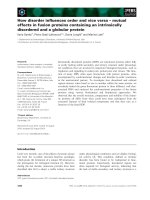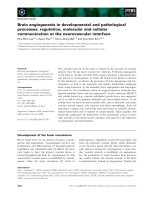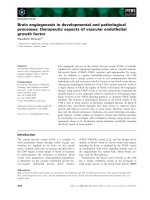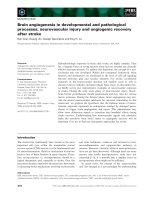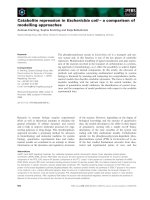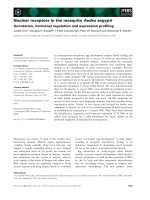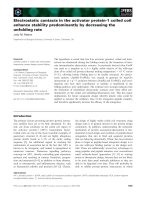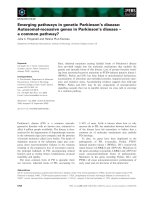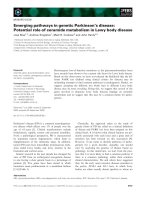Tài liệu Báo cáo khoa học: "DISCOURSE ENTITIES IN JANUS" pot
Bạn đang xem bản rút gọn của tài liệu. Xem và tải ngay bản đầy đủ của tài liệu tại đây (664.29 KB, 8 trang )
DISCOURSE ENTITIES IN JANUS
Damaris M. Ayuso
BBN Systems and Technologies Corporation
10 Moulton Street
Cambridge, Massachusetts 02138
Abstract
This paper addresses issues that arose in apply-
ing the model for discourse entity (DE) generation in
B. Webber's work (1978, 1983) to an interactive multi-
modal interface. Her treatment was extended in 4
areas: (1)the notion of context dependence of DEs
was formalized in an intensional logic, (2)the treat-
ment of DEs for indefinite NPs was modified to use
skolem functions, (3)the treatment of dependent
quantifiers was generalized, and (4) DEs originating
from non-linguistic sources, such as pointing actions,
were taken into account. The discourse entities are
used in intra- and extra-sentential pronoun resolution
in BBN Janus.
1 Introduction
Discourse entities (DEs) are descriptions of ob-
jects, groups of objects, events, etc. from the real
world or from hypothesized or possible worlds that are
evoked in a discourse. Any communicative act, be it
spoken, written, gestured, or system-initiated, can
give rise to DEs. As a discourse progresses, an ade-
quate discourse model must represent the relevant
entities, and the relationships between them (Grosz
and Sidner, 1986), A speaker may then felicitously
refer anaphorically to an object (subject to focusing or
centering constraints (Grosz et al., 1983, Sidner 1981,
1983, Brennan et al. 1987) ) if there is an existing DE
representing it, or if a corresponding DE may be
directly inferred from an existing DE. For example,
the utterance "Every senior in Milford High School has
a car" gives rise to at least 3 entities, describable in
English as "the seniors in Milford High School",
"Milford High School", and "the set of cars each of
which is owned by some senior in Milford High
School". These entities may then be accessed by the
following next utterances, respectively:
"They graduate in June."
"It's a good school."
"They completely fill the parking lot."
Webber (1978, 1983) addressed the question of
determining what discourse entities are introduced by
a text. She defined rules which produce "initial
descriptions" (IDs) of new entities stemming from
noun phrases, given a meaning representation of a
text. An ID is a logical expression that denotes the
corresponding object and uses only information from
the text's meaning representation. The declarative
nature of Webber's rules and the fact that they relied
solely on the structure of the meaning representation,
made her approach well suited for implementation.
The present work recasts her rules in Janus's in-
tensional logic framework (described in section 2).
Two goals guided our approach: (1)that our DE
representations be semantically clear and correct ac-
cording to the formal definitions of our language, and
(2) that these
representations
be amenable to the
processing required in an interactive environment
such as ours, where each reference needs to be fully
resolved against the current context.
In the following sections, we first present the
representational requirements for this approach, and
introduce our logical language (section 2).
Then we discuss issues that arose in trying to
formalize the logical representation of DEs with
respect to (1) the context dependence of their denota-
tions, and (2) the indeterminacy of denotation that
arises with indefinite NPs. For context dependence,
we use an intensional logic expression indexed by
time and world indices (discussed in section 3). This
required us to extend Webber's rules to detect modal
and other index-binding contexts. In representing
DEs for indefinites
(appearing as
existential formulae
in our meaning representation), we replaced
Webber's EVOKE predicate with skolem constants for
the independent case, where it does not contain a
variable bound by a higher FORALL quantifier
(section 4), and do not use EVOKE at all in the de-
pendent case.
In section 5 we introduce a generalized version of
the rules for generating DEs for dependent quantifiers
stemming from indefinite and definite NPs which
over-
comes some difficulties in capturing dependencies be-
tween discourse entities.
In our multi-modal interface environment, it is im-
portant to represent the information on the computer
screen as part of the discourse context, and allow
references to screen entities that are not explicitly in-
troduced via the text input. Section 6 briefly dis-
cusses some of these issues and shows how pointing
actions are handled in Janus by generating ap-
propriate discourse entities that are then used like
other DEs.
Finally, section 7 concludes and presents plans
for future work.
This is, to our knowledge, the first implementation
of Webber's DE generation ideas. We designed the
243
algorithms and structures necessary to generate dis-
course entities from our logical representation of the
meaning of utterances, and from pointing gestures,
and currently use them in Janus's (Weischedel et al.,
1987, BSN, 1988) pronoun resolution component,
which applies centering techniques (Grosz et al.,
1983, Sidner 1981, 1983, Brennan et al. 1987) to
track and constrain references. Janus has been
demonstrated in the Navy domain for DARPA's Fleet
Command Center Battle Management Program
(FCCBMP), and in the Army domain for the Air Land
Battle Management Program (ALBM).
2 Meaninq Representation for DE
Generation
Webber found that appropriate discourse entities
could be generated from the meaning representation
of a sentence by applying rules to the representation
that are strictly structural in nature, as long as the
representation reflects certain crucial aspects of the
sentence. This has the attractive feature that any
syntactic formalism may be used if an appropriate
semantic representation is produced. Some of the
requirements (described in (Webber 1978, 1983)) on
the representation are: (1) it must distinguish be-
tween definite and indefinite NPs and between sin-
gular and plural NPs, (2)it must specify quantifier
scope, (3) it must distinguish between distributive and
collective readings, (4)it must have resolved elided
verb phrases, and (5) it must reflect the modifier struc-
ture of the NPs (e.g., via restricted quantification). An
important implied constraint is that the representation
must show one recognizable construct (a quantifier,
for example) per DE-invoking noun phrase. These
constructs are what trigger the DE generation rules.
Insofar as a semantic representation reflects all of
the above in its structure, structural rules will suffice
for generating appropriate DEs, but otherwise infor-
mation from syntax or other sources may be neces-
sary. There is a trade-off between using a level of
representation that shows the required distinctions,
and the need to stay relatively close to the English
structure in order to only generate DEs that are jus-
tiffed by the text. For example, in Janus, in addition to
quantiflers from NPs, the semantic representation has
quantiflers for verbs (events), and possibly extra
quantifiers introduced in representing deeper meaning
or by the collective/distributive processing. Therefore,
we check the syntactic source of the quantifiers to
ensure that we only generate entities for quantifiers
that arose from NPs (using the bound variable as an
index into the parse tree).
Other than the caveat just discussed, the Janus
meaning representation language WML (for World
Model Language) (Hinrichs et al., 1987) meets all the
other constraints for DE generation. WML is a higher-
order intensional language that is based on a syn-
thesis between the kind of language used in PHLIQA
(Scha, 1976) and Montague's Intensional Logic
244
(Montague, 1973). A newer version of WML (Stallard,
1988) is used in the 8BN Spoken Language System
(Boisen et al., 1989). The intensionality of WML
makes it more powerful than the sample language
Webber used in developing her structural rules.
The scoping expressions in WML have a sort field
(which restricts the range of the variable) and have
the form:
(1= x s (P x))
where B is a quantifier such as FORALL or EXISTS, a
term-forming operator like IOTA or SET, or the
lambda abstraction operator LAMBDA. S is the sort,
a set-denoting expression of arbitrary complexity
specifying the range of x, and (P x) is a predication in
terms of x. The formal semantics of WML assigns a
type to each well-formed expression which is a func-
tion of the types of its parts. If expression E has type
T, the denotation of E, given a model M and a time t
and world w, is a member of the set which is T's
domain. One use of types in our system is for enforc-
ing selectional restrictions. The formation rules of
WML, its type system, and its recursive denotation
definition provide a formal syntax and semantics for
WML.
3 Context Dependence of Discourse
Entities
A formal semantics was assumed though not
given for the sample logical language used by Web-
bar. The initial descriptions (IDs) of DEs produced by
her rules were stated in this language too, and thus
are meant to denote the object the DE represents.
For example, the rule which applies to the represen-
tation for independent definite NPs assigns to the
resulting DE an ID which is the representation itself:
(t x S (P x)) => ID: (t x S (P x))
where t is Russell's iota operator. Thus, the ID for
"the cat" in "1 saw the cat" is (t x cats T). (Since the
body of the t in this example has no additional
predication on x, it is merely T, for TRUE.) However,
because IDs are solely drawn from the meaning
representation of the isolated text, they may not suf-
fice to denote a unique object. Connection to prior
discourse knowledge or information from further dis-
course may be necessary to establish a unique
referent, or determining the referent may not even be
necessary. For example, the ID for "the cat" would
need to be evaluated in a context where there is only
one salient cat in orddr to obtain a denotation.
Our system's representation of a DE is a structure
containing several fields. The "logical-form" field con-
tains a WML expression which denotes the object the
DE'describes (this corresponds roughly to Webber's
ID). Given that WML is intensional, we are able to
explicitly represent context dependence by having the
logical form include an intensional core, plus tense,
time, and world information (which includes discourse
context) that grounds the intension so that it may be
evaluated. For example, the logical form for the DE
corresponding to "the cat" in our system is
( (Z~'~'ZNSION (IOTA x eat- T) )
time world)
where time, if unfilled, defaults to the present, and
world defaults to the real world and current discourse
state. The semantics of our IOTA operator makes it
denotationless if there is not exactly one salient object
that fits the description in the context, else its denota-
tion is that unique object. In our interactive system
each reference needs to be fully resolved to be used
successfully. If unknown information is necessary to
obtain a unique denotation for a IOTA term, a simple
clarification dialogue should ensue. (Clarification is
not implemented yet, currently the set of all values
fitting the IOTA is used.)
An example using the time index is the noun
phrase "the ships that were combat ready on
12/1/88", which would generate a DE with logical
form:
( ( INTENS ION
(PAST ( INTENSION
(IOTA x (SETS ,,hips)
(COMBAT-READY x) ) ) ) )
12/1/88 world)
Representing this time index in the logical form is cru-
cial, since a later reference to it, made in a different
time context must still denote the original object. For
example, "Are they deployed?" must have "they"
refer to the ships that were combat ready on 12/1/88,
not at the time of the latter utterance.
In order to derive the proper time and world con-
text for the discourse entities, we added structural
rules that recognize intensional and index-binding
logical contexts. Our DE generation algorithm uses
these rules to gather the necessary information as it
recurses into the logical representation (applying rules
as it goes) so that when a regular rule fires on a
language construct, the appropriate outer-scoping
time/world bindings will get used for the generated
DEs.
It should be noted that, as the discussion above
suggests, a definite NP always gives rise to a new
discourse entity in our system. If it is determined to
be anaphoric, then a pointer to the DE it co-refers with
(when found) will be added to its "refers-to" field, in-
dicating they both denote the same object.
4
DEs for Independent Indefinite
NPs
In Webber's work, the initial description (ID) for a
DE stemming from an independent existential (i.e.,
with no dependencies on an outer FORALL
quantifier), contained an EVOKE predicate. "1 saw a
cat":
(EXISTS x cat8 (maw I x))
would generate a DE with ID:
(t x Gat8
(&
(saw I x) (EVOI~ Sent x)))
"The cat I saw that was evoked by sentence Sent",
where Sent is the parsed clause for '1 saw a cat".
The purpose of EVOKE was to make clear that al-
though more than one cat may have been seen, the
"a" picks out one in particular (which one we do not
know except that it is the one mentioned in the
utterance), and this is the cat which makes the
EVOKE true. Any subsequent reference then picks
out the same cat because it will access this DE. The
semantics of the EVOKE predicate and the type of the
S argument (which is syntactic in nature) were un-
clear, so we looked for a different formulation with
better understood semantics.
Predicate logic already provides us with a
mechanism for selecting arbitrary individuals from the
domain via skolem functions (used as a mechanism
for removing existentials from a formula while preserv-
ing satisfiability). Skolem functions have been used in
computational linguistics to indicate quantifier scope,
for example (VanLehn, 1978). Following a suggestion
by R. Scha, we use skolem functions in the logical
form of the DE for the "indefinite individuals" intro-
duced by independent existentials (Scha et al., 1987).
For clarity and consistency with the rest of the lan-
guage, we use a sortedskolem form, where the range
of the function is specified. Since we use this for
representing existentials that are independent, the
function has no arguments and is thus equivalent to a
sorted constant whose denotation is undetermined
when introduced. (In this sense it is consistent with
Karttunen's (1976) and Kamp's (1984) view of the
indefinite's role as a referential constant, but unlike
Kamp, here the sentence's meaning representation is
separate from the representation of the evoked
entity.)
Thus we introduced a new operator to WML
named SKOLEM, for expressions of the form
(SKOLEM n <sort>), where n is an integer that gets
incremented for each new skolem created, as a way
of naming the skolem function. For the example
above, the core logical form (stripping the outer inten-
sion and indices) for the DE of "a cat" would be:
(SKOL~M I (SET x oats (saw I x)))
denoting a particular cat from the set of aJl the cats I
saw. The type of a SKOLEM expression is well-
defined and is given by the following type rule:
TYPEO¥
(SKOZJCN Ib"~G~S (SETS
a))
= a
where INTEGERS is the type for integers, and (SETS
a) is the type of sets whose members have type a.
This type rule says that when the first argument of
SKOLEM is of type INTEGER, and the second is a set
with elements of type a, then the type of the SKOLEM
expression is a. Therefore, the type of the above
example is cats. The explicit connection to the
originating sentence which the EVOKE predicate
provided is found in our scheme outside of the logical
245
representation by having a pointer in the DE's struc-
ture to the parse tree NP constituent, and to the struc-
ture representing the communicative act performed by
the utterance (in the fields "corresponding-constituent"
and
"originating-communicative-act", respectively).
These connections are used by the pronoun resolu-
t/on algorithms which make use of syntactic infor-
mation.
Does the denotation of a skolem constant ever get
determined? In narrative, and even in conversation,
identifying the individual referred to by the indefinite
NP frequently doesn't occur. However, in our inter-
active system, each reference must be fully resolved.
When the evaluation component of Janus determines
a successful value to use for the existential in the
text's logical form, the appropriate function denotation
for SKOLEM n gets defined, and the "extension" field
is set for the discourse entity.
Note that many interesting issues come up in the
treatment of reference to these indefinite entities in a
real system. For example, cooperative responses by
the system introduce new entities that must be taken
into account. If the user asks "Is there a carrier within
50 miles of Hawaii?", a cooperative "There are two:
Constellation and Kennedy" (as opposed to just
"Yes") must add those two carriers as entities, which
now overshadow the singular skolem entity for "a car-
der within 50 miles of Hawaii". On the other hand, a
"No" answer should block any further reference to the
carrier skolem, since its denotation is null, while still
allowing a reference to a class entity derived from it,
as in "Is there
one
near San Diego?" where
one
refers
to the class
carriers.
The treatment presented works for straightforward
cases of independent indefinites. Trickier cases like
donkey sentences (Kamp, 1984, Webber, 1981) and
interactions with negation have not yet been ad-
dressed.
5 Dependent NPs
5.1
Dependent Indefinite NPs
Our work uncovered a need for modifications in
Webber's structural rules for quantifiers from indefinite
and definite NPs which have dependencies on vari-
ables bound directly or indirectly by an outer FORALL
quantifier. In this section we address the case of
dependent existentials arising from indefinite NPs.
We first argue that the predicate EVOKE is not
needed in this context. Then we point out the need
for generalizing the rule to take into account not just
FORALL, but all scoping operators that intervene be-
tween the outer FORALL and the inner EXISTS.
Finally, we show that the dependencies between dis-
course entities must be explicitly maintained in the
logical forms of newly created DEs that depend on
them.
Webber's rules are designed to apply from the
outermost quantifier in; each time a rule is applied the
remaining logical form is modified to be in terms of the
just created DE. For example, "Every boy saw a girl
he knows" has logical form (for the bound pronoun
reading):
(FOR~LL x boys
(EXISTS y (SET y' girls
(knows
x
y' ) )
(SaW
x y) )
)
The first step is to apply the rule for an independent
universal quantifier:
R0: (FORALL x S (P x)) => de: S
This application yields the entity for "the set of all
boys"
DE I : boys
and we rewrite the logical form to be:
(FORALL x
DE 1
(EXISTS y (SET y' girls
(knows x y'))
(saw x y) ) )
The steps shown so far are consistent with both
Webber's and our approach. Now we want to apply
the general rule for existentials within the body of a
distributive, in order to generate an entity for the
relevant set of girls. Webber uses Rule 3 in (Webber,
1983) (here corrected to position the existential's sort
S inside the scope of the outer quantifiers in the
generated DE):
R3:
(¥O~,~.lr.,L
YI"''Yk
(EXISTS x s (P x))) =>
de: (SET x things
(EXISTS YI" • "Yk
(a
(msmbQr x
S)
(P x)
(EVOKE Ssnt x) ) ) )
where FORALL Yl""Yk is shorthand for FORALL Yl
de 1 ( (FORALL Yk dek, analogously for EXISTS, and
S or P depends directly or indirectly on Yl ""Yk'
Now the first DE we want to generate with this rule
is for "the set of girls, each of which is known by some
boy in DE 1, and was seen by him". Does each girl in
the set also have to satisfy an EVOKE predicate? It
seems that any future reference back to the set
formed by the existential seeks to obtain
a/I
items
fitting the description, not some subset constrained by
EVOKE. For example, if the example above is fol-
lowed by "the girls tried to hide", taking "the girls"
anaphorically, one wants
a/I
the girls seen by some
boy in DE 1 that knows them, no less. Our core logical
representation for the set of girls is thus:
DEE: (SET y girls
(EXISTS x DE I
(a (knows x y) (saw x y))))
So the modified rule used in producing DE 2
is:
246
R3': (¥ORALL y~ yk
(EXISTS
x
S (P x)))
=>
de: (SET
x
S t
(EXISTS YI"" "Yk
(a ( ~.r
x
s) (]~ x))))
where EVOKE has been removed, and the DE's sort
field is S t for the "root type" of S, which is the type of
the members of S, in order to appropriately constrain
the DE's sort (instead of leaving it as the uncon-
strained "things").
A second change that needs to be made is to
generalize the left hand side of the rule so that the
scoping expressions outscoping the inner EXISTS in
the pattern also be allowed to include other scoping
operators, such as EXISTS and IOTA. As long as the
outermost quantifier is a FORALL, any other depend-
ent scoping expression within it will generate a set-
denoting DE and will behave as a distributive environ-
ment as far as any more deeply embedded expres-
sions are concerned. In other words, the distribu-
tiveness chains along the dependent quantifiers. To
see this, consider the more embedded example
"Every boy gave a girl he knew a peach she wanted",
where there is an intervening existential between the
outer FORALL and innermost EXISTS. The core logi-
cal form for this sentence
is:
(FORALL x boye
(EXISTS y (SET y' girls
(knowe
x
¥' ) )
(EXISTS
z
(SET z' ~aohea
(wan*:a
y z' ) )
(gave
z
y z))))
DE 1 would be as above. Using rule R3' DF_. 2 be-
comes:
DE 2 :
(SET
y
girle
(EXISTS x DE I
(a
(knowe x
y)
(EXISTS z (SET z' peaches
(wants
Y
=') )
(gave
x
y =)))))
"The set of girls, each of which is known by some boy
in DE 1, and got a peach she wanted from that boy."
Now the peach quantifier should generate a set DE in
terms of DE 1 and DE 2. Applying R3' gives us:
DE3: (SET
z
peachee
(EXISTS x DE I
(EXISTS y DE 2
(a
(wanta
y
z)
(gave x
y
z)))))
"The set of peaches z such that there is a girl in DE 2
(who is known by some boy in DE I, and who got
some peach she wan.tpd from the boy), who wants z,
and who got it from some boy in DE 1''.
Now a third and final problem becomes apparent:
for the general case of arbitrary embedding of de-
pendent quantifiers we generate a DE (e.g., DF_,3) de-
pendent on other DEs from the outer quantifiers, but
the
dependencies between those DEs
(e.g., DE 1 and
DE2) are not maintained. This is counter-intuitive, and
also leads to an under-specified set DE. In the
peaches example above, envision the situation where
a boy b I gave out two peaches Pl and
P2
: one to a
girl gl he knew, and one to a girl
g2
he
didn't
know,
who also got a peach
P3
from another boy
b 2
who
did
know her. These are the facts of interest in this
scenario:
I.
(& (gava
b I gl p1)
(know
b I gl)
(want= gl Pl))
2. (& (gave
blg2P2)
(NOT
(know
bl gE) )
(wanta
gEPE) )
3. (& (gave
bEgEp 3)
(know
bEgE)
(wants
g2 P3 ) )
Since b 1 and b 2 are in DE 1 (due to facts 1 and 3), and
g2 is in DE 2 (due to fact 3), then
P2
is in DE 3 (due to
fact 2 and according to the DF_. 3 logical form above).
But
P2 should notbe
in DE 3, since
P2
was NOT given
to a girl by a boy
she knew.
The set of peaches
obtained for DE 3 is too large. The problem would not
arise if in the DE 3 logical form, the variables ranging
over DF 2 were appropriately connected to DE 1 using
the dependent restriction present in the original for-
mula
(knows xy).
A correct DE 3 is:
DE 3 :
(SET z ~:Hmache,=
(EXISTS x DE z
(EXISTS
y
(SET y' DE 2
(knows x y' ) )
(&
(want= y
=)
(gave
x y z)))))
To be able to do this, the rule-application algorithm
must be modified to include the restriction information
(for dependent restrictions) when the formula gets
rewritten in terms of a newly created DE. Therefore
the final generalized rule, which includes other scop-
ing operators and works on properly connected DEs is
as follows:
R3''
:
(¥ORALL v I S I
(Q2
v2
S2
"'"
Q. v S=
(EXISTS x S (P x))))
=>
de: (SET x S t
(EXISTS v I S I v= S
(~
(mem~r x S) (~ x))))
where S or P depend directly or indirectly on v 1 v n,
Qi may be FORALL, EXISTS, or IOTA, and the scop-
ing operators outside the inner EXISTS have already
been processed by any appropriate rules that have
replaced their original sorts by the Sis, which are in
terms of generated DEs and explicitly show any DE
dependencies. The right hand side is as before, with
existentials picking out elements from each outer
quantifier.
247
act. Since "them" and *it" have different number re-
quirements, there is no ambiguity and the anaphor
resolution module resolves "them" to the DE cor-
responding to "the C1 carriers in the Indian Ocean"
and "it" to the DE for Kennedy. We are currently
working on having system-initiated actions also
generate entities.
7
Conclusions and Further Work
Webber's general approach to discourse entity
generation from a logical representation proved very
useful in our efforts. We were able to recast her basic
ideas in our logical framework, and currently use the
generated DEs extensively.
The fact that the generation of DEs is done via
structural rules operating on a semantic represen-
tation provided a degree of modularity that allowed
our pronoun resolution component to work
automatically when we combined a new syntactic
component with our semantic and discourse com-
ponent (replacing an ATN by a unification grammar, in
an independently motivated experiment). We are cur-
rently starting to port the DE generation component to
the BBN Spoken Language System (Boisen et al.,
1989),
and plan to integrate it with the intra-sentential
mechanisms in (Ingria and Stallard, 1989). The fact
that entity representations are mostly semantic in na-
ture, not syntactic, also facilitated the addition and use
of non-linguistic entities in a uniform way.
There are several areas that we would like to
study to extend our current treatment. We want to
address the interactions between centering
phenomena and non-linguistic events that affect dis-
course focus, such as changing contexts via a menu
selection in an expert system.
Our paraphrasing component (Meteer and
Shaked, 1988) already uses the discourse entities to
a limited extent. One area of future work is to have
the language generator make more extensive use of
them, so it can smoothly refer to focused objects.
Finally, although quantified expressions are al-
ready generated in Janus for events implicit in many
verbs, they are not being used for DEs. We would
like to address the problem of event reference and its
interaction with temporal information, using ideas
such as those in (Webber, 1988) and in the special
issue of ComputationaJ Linguistics on tense and
aspect (Vol. 14, Number 2 June 1988).
8
Acknowledgments
The work presented here was supported under
DARPA contract #N00014-85-C-0016. The views and
conclusions contained in this document are those of
the author and should not be interpreted as neces-
sarily representing the official policies, either ex-
pressed or implied, of the Defense Advanced
Research Projects Agency or of the United States
Government. The author would like to thank Dave
Stallard for invaluable discussions during the writing
of this paper. Thanks also to Remko Scha, Lance
Ramshaw, Ralph Weischedel, and Candy Sidner.
References
BBN Systems and Technologies Corp. (1988). A
Guide to IRUS-II Application Development in
the FCCBMP (BBN Report 6859). Cambridge,
MA: Bolt Beranek and Newman Inc.
Boisen, S., Chow Y., Haas, A, Ingria, R., Roucos, S.,
Scha, R., Stallard, D., and Vilain, M. (1989).
Integration of Speech and Natural Language:
Final Report (BBN Report 6991 ). BBN Systems
and Technologies Corp.
Brennan, Susan E., Friedman, Marilyn W., and Pol-
lard, Carl J. (1987). A Centering Approach to
Pronouns. Proceedings of the 25th Annual
Meeting of the ACL. ACL.
Grosz, Barbara J., and Sidner, Candace L. (1986).
Attention, Intentions, and the Structure of Dis-
course. Computational Linguistics, 12(3),
175-204.
Grosz, Barbara J., Joshi, Aravind K., Weinstein, Scott.
(1983). Providing a Unified Account of Definite
Noun Phrases in Discourse, Proceedings of
the 21st Annual Meeting of the ACL.
Cambridge, MA: ACL.
Hinrichs, E.W., Ayuso, D.M., and Scha, R. (1987).
The Syntax and Semantics of the JANUS
Semantic Interpretation Language. In
Research and Development in Natural Lan-
guage Understanding as Part of the Strategic
Computing Program, Annual Technical Report
December 1985 . December 1986. BBN
Laboratories, Report No. 6522.
Ingria, Robert J.P., and Stallard, David. (1989). A
Computational Mechanism for Pronominal Ref-
erence. Proceedings of the 27th Annual Meet-
ing of the ACL. ACL.
Kamp, Hans. (1984). A Theory of Truth and Seman-
tic Representation. In J. Groenendijk. T.M.V.
Janssen, and M. Stokhof (Eds.), Truth, Inter-
pretation and Information, Selected Papers
from the Third Amsterdam Colloquium.
Dordrecht: Foris Publications.
Karttunen, Laud. (1976). Discourse Referents. In
J. D. McCawley (Ed.), Syntax and Semantics,
Volume 7. New York: Academic Press.
Meteer, Marie and Shaked. Varda. (1988). Strategies
for Effective Paraphrasing. Proceedings of
COLING-88, Budapest, Hungary, August 22-27.
COLING.
248
5.2 Dependent Definite NPs
Some of the problems described in the previous
section also arise for the rule to handle dependent
definite NPs. Definite NPs are treated as IOTA terms
in WML. (Webber's logical language in (Webber,
1978) used a similar t. The treatment was later
changed (Webber, 1983) to use the definite existential
quantifier "Existsl', but this difference is not relevant
for the following.) Replacing IOTA for t in Webber's
(1978) rule 5:
R5:
(FOt~,,L Y~.'''Yk
(P (IOTA x S (~ x)))) =>
de:
(SET
z
things
(EXISTS YI"" "Yk
(m z (IOTA x S (R =)))))
where Yl'"Yk are universal quantifiers over DEs as in
R3 above, and S or R depend directly or indirectly on
Yl"'Yk"
The second and third extensions discussed in the
previous section are needed here too: generalizing
the quantifiers that outscope the inner existential, and
keeping the dependencies among the DEs explicit to
avoid under-specified sets. An example of an under-
specified set arises when the dependent IOTA
depends jointly on more than one outer variable; for
example, in "Every boy gave a girl he knew the peach
they
selected", each peach depends on the selection
by a boy and a girl together. Take a scenario
analogous to that in the previous section, with the
facts now as follows (replacing "selected" for "wants*):
1. (&
(gave by gl P~) (know b r gl)
(8ele,=ted
(SETOF bl gl) pr ) )
2. (& (gave
b t g2P2)
(NOT (know
b I g2)
)
(=elected (SETO¥
b 1 g2) P2) ) "
3.
(&
(gave
b292P3)
(know
b292)
(=ele¢ted (SETOF
b292) P3))
By an analogous argument as before, using R5, the
set of peaches will incorrectly contain
P2'
given by a
boy to a girl who selected it with him, but whom he did
not know. The modified rule is analogous to R3" in
the previous section:
RS' : (FORALL v I S I
(Q= v z s=
O~
v= s=
(p
(IOTA x s (R
x)))))
=>
de:
(SET
z
S t
(EXISTS v I S I v S
(= z (IOTA x S (R x)})))
Note that this problem of under-specified sets
does not arise when the dependency inside the IOTA
is on one variable, because the definite "the" forces a
one-to-one mapping from the possible assignments of
the single outer variable represented in the IOTA to
the IOTA denotations. If we use the example, "Every
boy gave a girl he knew
the
peach she wanted", with
logical form:
(FORALL x boys
(EXISTS y (SET y' gi=is
(know= x y' ) )
(gave x y (IOTA z pea=hem
(want,, y =) ) ) ) )
there is such a mapping between the set of girls in the
appropriate DE 2 (those who got the peach they
wanted from a boy they knew) and the peaches in
DE 3 obtained via R5' (the peaches that some girl in
DE 2 wanted). Each gid wants exactly one peach, so
facts 2 and 3, where the same girl receives two dif-
ferent peaches, cannot occur. So the definite ensures
that no scenario can be constructed containing extra
items, as long as there is only one outer variable in
the inner iota. However in the joint dependency ex-
ample above using "selected", the one-to-one map-
ping is between boy-girl
pairs
and peaches, so the
relationship between the boys and the girls becomes
an integral part of determining the correct DE 3.
6
Non-Linguistic Discourse Entities
In a dialogue between persons, references can be
made not only to linguistically-introduced objects, but
also to objects (or events, etc.) that become salient in
the environment through some non-linguistic means.
For example, a loud noise may prompt a question
"What was
that
?", or one may look at or point to an
object and refer to it, "What's wrong with
it
?". It
seems an attention-drawing event normally precedes
such a reference.
In the Janus human-computer environment, non-
linguistic attention-drawing mechanisms that we have
identified so far include pointing actions by the user,
and highlighting (by the system) of changes on the
screen as a response to a request (or for other
reasons). The appearance of answers to questions
also draws the user's attention. We incorporated
these into generalized notion of a "communicative
act" which may be linguistic in nature (English input or
generated English output), a pointing gesture by the
user, or some other system-initiated action. Any com-
municative act may give rise to DEs and affect the
focused entities in the discourse.
We have implemented procedures to handle
pointing actions by generating discourse entities
which are then used in the pronoun resolution com-
ponent uniformly with the others. For example, after
the request *Show me the C1 carriers in the Indian
Ocean" the system will display icons on the color
monitor representing the carriers. The user can then
say "Which of them are within 200 miles of it? <point
with mouse to Kennedy>*. Before the sentence gets
processed, a discourse entity with the logical form
(IOTA x carriers (nameof x "Kennedy")) • will be
created and added to the list of entities currently in
focus (the "forward looking centers* of the last linguis-
tic act); the DE's "originating-communicative-act" field
will point to a newly created "pointing" communicative
249
Montague, Richard. (1973). The Proper Treatment of
Quantification in Ordinary English. In
J. Hintikka, J. Moravcsik and P. Suppes (Eds.),
Approaches to Natural Language.
Dordrecht:
Reidel.
Scha, Remko J.H. (1976). Semantic Types in
PHLIQAI.
Coling 76 Preprints.
Ottawa,
Canada.
Scha, Remko J.H., Bruce, Bertram C., and Polanyi,
Livia. (1987). Discourse Understanding. In
Encyclopedia of Artificial Intelligence.
John
Wiley & Sons, Inc.
Sidner, Candace L. (1981). Focusing for the Inter-
pretation of Pronouns.
American Journal of
Computational Linguistics,
7(4), 217-231.
Sidner, Candace L. (1983). Focusing in the Com-
prehension of Definite Anaphora. In M. Brady
and R. C. Berwick (Eds.),
Computational
Models of Discourse.
Cambridge, MA: MIT
Press.
Stallard, David G. (1988). A Manual for the Logical
Language of the BBN Spoken Language Sys-
tem. Unpublished.
Kurt VanLehn. (1978).
Determining the Scope of
English Quantifiers
(Tech. Rep. 483). MIT Ar-
tificial Intelligence Laboratory.
Webber, Bonnie L. (1978).
A Formal Approach to
Discourse Anaphora
(BBN Report 3761).
Cambridge, MA: Bolt Beranek and Newman.
Webber, Bonnie L. (1981). Discourse Model Syn-
thesis: Preliminaries to Reference. In Joshi,
Webber, and Sag (Eds.),
Elements of Dis.
course Understanding.
Cambridge University
Press.
Webber, Bonnie L. (1983). So What Can We Talk
About Now? In Brady and Berwick (Eds.),
Computational Models of Discourse.
MIT
Press.
Webber, Bonnie L. (1988). Discourse Deixis: Refer-
ence to Discourse Segments.
Proceedings of
the 26th Annual Meeting of the ACL.
ACL.
Weischedel, R., Ayuso, D., Haas, A., Hinrichs, E.,
Scha, R., Shaked, V., and Stallard, D. (1987).
Research and Development in Natural Lan-
guage Understanding as Part of the Strategic
Computing Program, Annual Technical Report
December 1985- December 1986
(BBN Report
6522).
Cambridge, MA: Bolt Beranek and
Newman.
250

